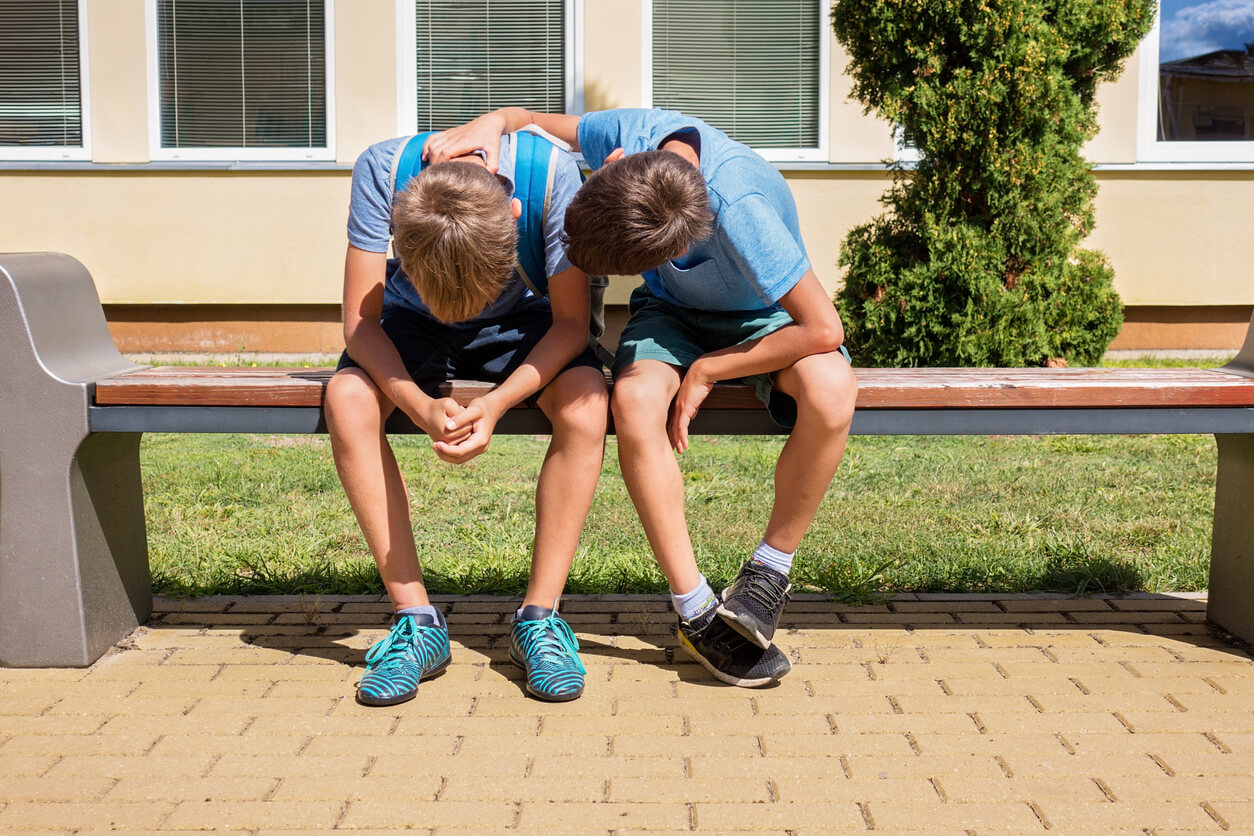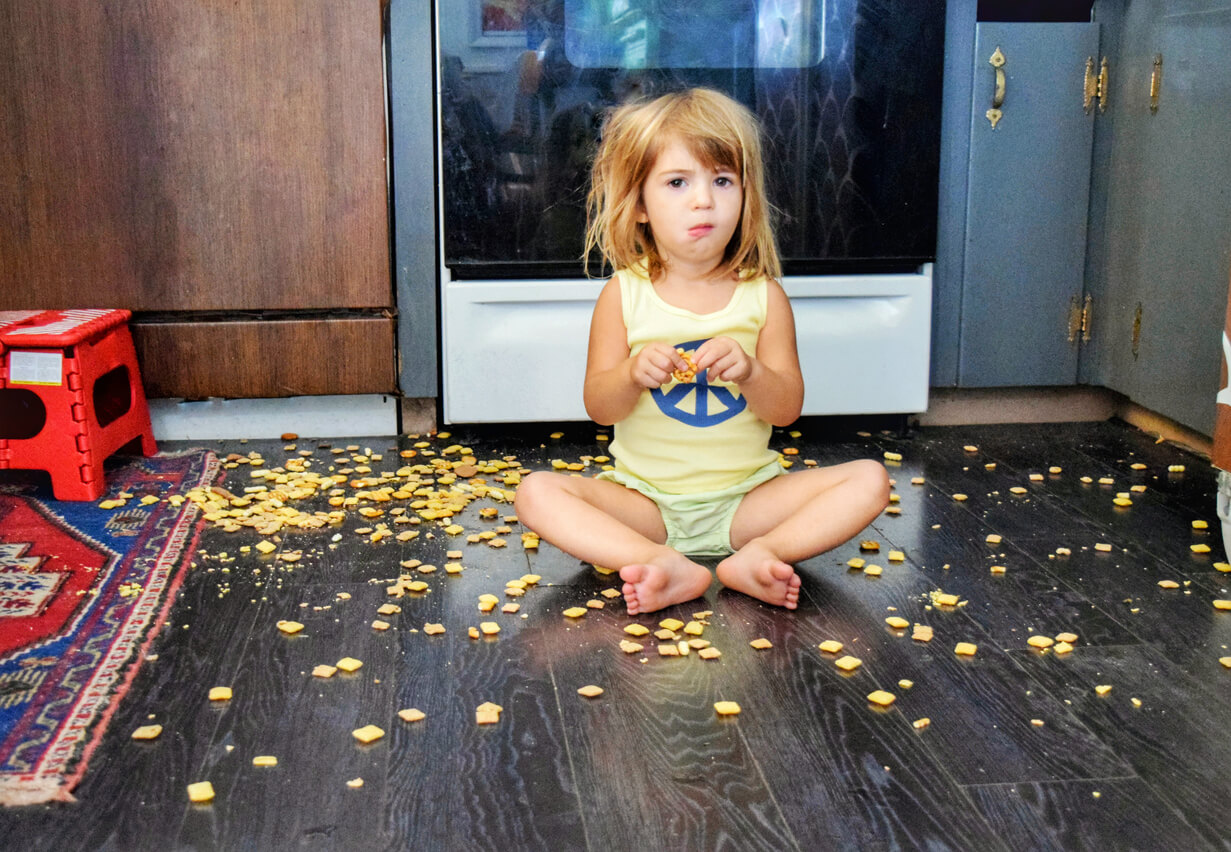Overadapted Children: What Are They Like?

Juan has just won a medal in the soccer tournament his father signed him up for, however, he doesn’t look happy. Chloe is an outstanding dancer, but every time she has to go to class, she feels a pain in the pit of her stomach. Elena is very mature for her age, but she doesn’t seem to feel comfortable in that role. What do these situations have in common? They’re all cases of overadapted children.
In each case, these children engage in different activities despite what they really want. They do it, but their body, their gestures, and their emotions show that they don’t really want to. They’re overadapted children, capable of compromising their well-being in order to receive the affection of their loved ones.
Overadapted children: What are they like?
Overadapted children display a facade of perfection and correctness. They’re those children whose parents define as those who “never give them any problems.”
However, it’s important to understand that this is a posture they adopt because they believe that this is what is expected of them. Therefore, they have little room for action, exploration, and learning.
The emotional cost of trying to be “perfect” is extremely high, as it requires adapting to the expectations and demands of others, with little registration of one’s own desires.
The consequences experienced by overadapted children are manifested at the emotional and psychological level. These children become accustomed to repressing their emotions, are insecure, depend on the gaze of others, have a low tolerance to frustration, and suffer from various psychosomatic discomforts.
Over time, these children grow up and their problems lead to anxiety and depression. In other cases, they may be victims of abusive and toxic relationships, as the message they’ve internalized throughout their lives is that in order to be loved, they must please others.

5 signs of overadapted children
- They’re quick to say yes. They never object to anything.
- They’re excessively responsible and demanding. They’re even very severe with themselves.
- The adults around them label them as “little role models” and everyone talks about them.
- They treasure a great amount of achievements and goals.
- Despite the latter, they’re not happy with them.
You may be interested in: Using Positive Demands to Raise Happy Children
How to accompany overadapted children
Here are some recommendations to help these children develop in a more conscious and connected way with their own emotions.
Allow them to choose what they want to be and work towards becoming it
At home, give them the option to express themselves, either to assert or oppose, but let them choose among different activities or possibilities themselves. At all times, take their opinion into account, especially before making decisions.
They may not be the ones to decide which school to attend, but they can decide the sport they want to participate in.
Reinforce their self-esteem
Let your children know that you love them just the way they are every day. Also, that they don’t need to conform to an ideal, because there’s no such thing.
Educate them on values
More than educating them to be little role models, the most important thing is that children understand what values you hold as a family and as individuals. In this way, throughout their development, they’ll be able to identify how to behave -according to those values- despite what’s asked of them.
Convey the message that they’re valuable, no matter what they choose
Respecting their tastes and supporting their decisions not only fosters their autonomy but also strengthens their self-esteem. This helps them feel more valuable and confident in who they are, without relying on the validation of others. Ultimately, such a message also impacts their mood and motivation.
Encourage communication with your children
Try to create and facilitate spaces for dialogue in your home where each person can express themselves empathetically and assertively about their feelings and emotions.
Allow them to explore, experiment, and break certain rules
It may surprise you, but children always learn from mischief. Of course, it’s about allowing them to exceed some “breakable” limits, but not those that are fundamental, that put them in danger, or that contradict the norms and values of the home.

Each child must live their own story
Many times, adults transfer unfulfilled personal expectations or projects onto children. In doing so, we leave them imprisoned in the “obligation” of having to satisfy their parents in order to see them happy. As a result, they put themselves in second place. This erodes their self-esteem and confidence, as it doesn’t respect their identity and uniqueness. And in the end, it interferes with the process of healthy psychological development.
For all of these reasons, it’s important to review where what we project onto children comes from and instead, encourage them to be who they want to be. Also, we must move away from comparison, because it’s a negative habit that benefits no one.
Finally, children should know that our affection doesn’t depend on how successful they are at what they do: We love and value them in good times and bad.
Juan has just won a medal in the soccer tournament his father signed him up for, however, he doesn’t look happy. Chloe is an outstanding dancer, but every time she has to go to class, she feels a pain in the pit of her stomach. Elena is very mature for her age, but she doesn’t seem to feel comfortable in that role. What do these situations have in common? They’re all cases of overadapted children.
In each case, these children engage in different activities despite what they really want. They do it, but their body, their gestures, and their emotions show that they don’t really want to. They’re overadapted children, capable of compromising their well-being in order to receive the affection of their loved ones.
Overadapted children: What are they like?
Overadapted children display a facade of perfection and correctness. They’re those children whose parents define as those who “never give them any problems.”
However, it’s important to understand that this is a posture they adopt because they believe that this is what is expected of them. Therefore, they have little room for action, exploration, and learning.
The emotional cost of trying to be “perfect” is extremely high, as it requires adapting to the expectations and demands of others, with little registration of one’s own desires.
The consequences experienced by overadapted children are manifested at the emotional and psychological level. These children become accustomed to repressing their emotions, are insecure, depend on the gaze of others, have a low tolerance to frustration, and suffer from various psychosomatic discomforts.
Over time, these children grow up and their problems lead to anxiety and depression. In other cases, they may be victims of abusive and toxic relationships, as the message they’ve internalized throughout their lives is that in order to be loved, they must please others.

5 signs of overadapted children
- They’re quick to say yes. They never object to anything.
- They’re excessively responsible and demanding. They’re even very severe with themselves.
- The adults around them label them as “little role models” and everyone talks about them.
- They treasure a great amount of achievements and goals.
- Despite the latter, they’re not happy with them.
You may be interested in: Using Positive Demands to Raise Happy Children
How to accompany overadapted children
Here are some recommendations to help these children develop in a more conscious and connected way with their own emotions.
Allow them to choose what they want to be and work towards becoming it
At home, give them the option to express themselves, either to assert or oppose, but let them choose among different activities or possibilities themselves. At all times, take their opinion into account, especially before making decisions.
They may not be the ones to decide which school to attend, but they can decide the sport they want to participate in.
Reinforce their self-esteem
Let your children know that you love them just the way they are every day. Also, that they don’t need to conform to an ideal, because there’s no such thing.
Educate them on values
More than educating them to be little role models, the most important thing is that children understand what values you hold as a family and as individuals. In this way, throughout their development, they’ll be able to identify how to behave -according to those values- despite what’s asked of them.
Convey the message that they’re valuable, no matter what they choose
Respecting their tastes and supporting their decisions not only fosters their autonomy but also strengthens their self-esteem. This helps them feel more valuable and confident in who they are, without relying on the validation of others. Ultimately, such a message also impacts their mood and motivation.
Encourage communication with your children
Try to create and facilitate spaces for dialogue in your home where each person can express themselves empathetically and assertively about their feelings and emotions.
Allow them to explore, experiment, and break certain rules
It may surprise you, but children always learn from mischief. Of course, it’s about allowing them to exceed some “breakable” limits, but not those that are fundamental, that put them in danger, or that contradict the norms and values of the home.

Each child must live their own story
Many times, adults transfer unfulfilled personal expectations or projects onto children. In doing so, we leave them imprisoned in the “obligation” of having to satisfy their parents in order to see them happy. As a result, they put themselves in second place. This erodes their self-esteem and confidence, as it doesn’t respect their identity and uniqueness. And in the end, it interferes with the process of healthy psychological development.
For all of these reasons, it’s important to review where what we project onto children comes from and instead, encourage them to be who they want to be. Also, we must move away from comparison, because it’s a negative habit that benefits no one.
Finally, children should know that our affection doesn’t depend on how successful they are at what they do: We love and value them in good times and bad.
All cited sources were thoroughly reviewed by our team to ensure their quality, reliability, currency, and validity. The bibliography of this article was considered reliable and of academic or scientific accuracy.
- Viviana Herskovic, Marcela Matamala, Somatización, ansiedad y depresión en niños y adolescentes, Revista Médica Clínica Las Condes, Volume 31, Issue 2, 2020, Pages 183-187, ISSN 0716-8640, https://doi.org/10.1016/j.rmclc.2020.01.006.
- Zurob, V. (2018). El sufrimiento invisible: la sobreadaptación en la escuela. Columnas de experto Chile crece contigo.
- Bonet de Luna, C., Fernández García, M., & Chamón Parra, M.. (2011). Depresión, ansiedad y separación en la infancia: Aspectos prácticos para pediatras ocupados. Pediatría Atención Primaria, 13(51), 471-489. https://dx.doi.org/10.4321/S1139-76322011000300012
This text is provided for informational purposes only and does not replace consultation with a professional. If in doubt, consult your specialist.








